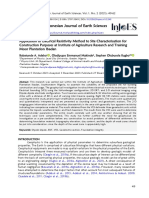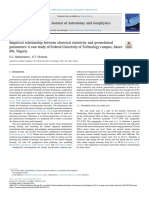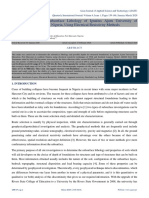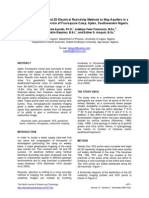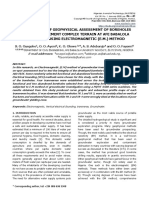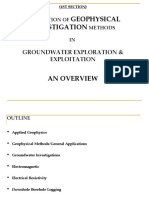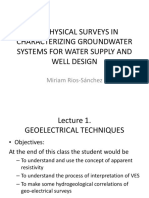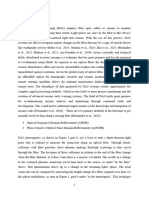Anukwu 2017
Uploaded by
Fellas DilnalsyahAnukwu 2017
Uploaded by
Fellas DilnalsyahE-ISSN : 2541-5794
P-ISSN : 2503-216X
Journal of Geoscience,
Engineering, Environment, and Technology
Vol 02 No 02 2017
Soil Structure Evaluation Across Geologic Transition Zones
Using 2D Electrical Resistivity Imaging Technique
Geraldine C. Anukwu 1,2,*, A. F. Adebara 1 , T.K. Abodunrin3, A. P Iwakun3
1
Department of Geosciences, University of Lagos, Akoka, Lagos, Nigeria.
2
Geophysics Program, School of Physics, Universiti Sains Malaysia, Pulau Pinang.
3
Department of Physics, Olabisi Onabanjo Univsersity, Ago-Iwoye, Nigeria.
* Corresponding author : geraldineijeoma@gmail.com
Received: 11 April, 2017. Revised : 2 May 2017, Accepted: 31 May, 2017, Published: 1 June 2017
DOI: 10.24273/jgeet.2017.2.2.195
Abstract
This study utilizes the electrical resistivity values obtained using 2-D Electrical resistivity imaging (ERI) technique to
evaluate the subsurface lithology across different geological units. The primary objective was to determine the effect of
subsurface lithology on the integrity of a road pavement, which had developed cracks and potholes at various locations. The
dipole-dipole configuration was utilized and a total of nine traverses were established in the study area, whose geology cuts
across both the basement and sedimentary complexes. The inverted resistivity section obtained showed significant variation
in resistivity along established traverses and also across the different rock units, with the resistivity value ranging from about
4 ohm-m to greater than 7000 ohm- m. The lithology as interpreted from the resistivity section revealed the presence topsoil,
clay, sandy clay, sand, sand stones/basement rocks, with varying vertical and horizontal arrangements to a depth of 40m.
Results suggest that the geologic sequence and structure might have contributed to the observed pavement failure. The
capability of the 2D ERI as an imaging tool is observed, especially across the transition zones as depicted in this study. The
study further stressed the ability of this technique if properly designed and implemented, to be capable of providing a wealth
of information that could complement other traditional geotechnical and geologic techniques.
Keywords: Electrical Resistivity Imaging, Transition zone, Ago-Iwoye, Nigeria
1. Introduction
1.1 Sub Introduction
As a means of ensuring the continuous integrity by the geophysical techniques is that they are
of engineering structures long after their generally non-invasive, non-destructive and of
completion, it is important that the subsurface on better spatial coverage (Sobreira et al 2010,
which such structures are built upon is properly Emujakporue, 2012). Some of the geophysical
considered. The presence of potholes, cracks, techniques that can be employed to achieve the
bulges/and or depressions are common occurrence desired information for investigating subsurface
along roads in southern part of Nigeria. Various conditions are: seismic refraction, seismic
factors have being attributed to the probable cause reflection, MASW, ReMi, Ground Penetrating Radar;
of failure which include poor quality construction, Electromagnetic Method; Electrical Resistivity,
improper design and specification, poor drainage Magnetic, (Wightman et al 2004; Anderson, 2008).
and improper usage, poor soil properties (Onuoha Electrical resistivity techniques have been
et al 2014). Most times, adequate attention is not successfully applied in characterizing the
given to the fact that the subsurface that provides subsurface for many years with applications
the needed support for the road can be a major ranging from hydrogeological, archeological,
cause of failure. Research have however shown that environmental and engineering studies (Adepelumi
there is need to put into consideration the geology and Olorunfemi, 2000; Rizzo et al 2005; Alaia et al
and geomorphology of the underlying earth 2007; Ariyo and Adeyemi, 2012).The electrical
materials as they can greatly affect the integrity of method makes use of the response of the subsurface
any road (Ajayi, 1987; Olorunfemi and Meshida, to current introduced into the ground via
1987; Momoh et al 2008 and Adiat et al 2009; electrodes. The measurements obtained can be used
Ayolabi and Adegbola, 2013, Igwe, 2015). to obtain apparent resistivity of the subsurface
To obtain a proper understanding of the materials, from which the true resistivity can be
characteristics of the underlying earth materials, implied. The resistivity distribution observed thus
various approaches can be adopted; one of such is forms the basis for identifying the earth materials
the geophysical techniques. The advantages offered present in such geologic environments. Resistivity
Anukwu et al./ JGEET Vol 02 No 02/2017 95
methods applied in road investigation has been occurrence of such failures along the studied road
reported by quite a number of researchers (Momoh and places with similar geological settings.
et al 2008; Oladapo et al 2008; Adiat et al 2009;
2. Geological Setting
Emujakporue, 2012). These authors in their works
utilized 1D resistivity measurements (Vertical The study area is located between longitude N
Electrical Sounding and/or profiling) to characterize 060 57.0711 N 070 00.3811 and latitude E 0030
the subsurface as well as identify faults and other 54.7721 E 003042.2711 respectively with an
geologic units that were detrimental to the integrity average elevation of 71 meters. The road
of the road. investigated in this study is the asphalt pavement
Advances in instrumentation and computer roadway from Ago-Iwoye to Ishara passing along
algorithm has led to the development of 2D, 3D Okegbe and Imagbon villages, all in Ogun State
electrical imaging technique using multi-electrode (Fig.1.).
resistivity systems which is more cost-effective and The road serves as a link between the University
capable of providing a better representation of the (Olabisi Onabanjo University) town of Ago-Iwoye
subsurface (Loke, 2004; Kumar, 2012; Metwaly and and another town Ishara which then connects to
AlFouzan, 2013). In the 2-D electrical imaging other major cities in the southwest these includes
method, resistivity changes in both vertical and Abeokuta, Lagos and Ibadan. As at the time this
horizontal direction along the survey line are study was conducted, the road had undergone
accounted for. Here, the implementation of the major failures on some portion, which necessitated
technique involves the use of a large number of this study to determine the effect of the subsurface
electrodes (>25). These electrodes are connected by conditions on the failure of the road.
means of a multi-core cable, which is in turn Rocks in the study area falls in both the
connected a switching unit (electrode selector) and Basement and Sedimentary complexes of sourth
to the resistivity meter. The electrode selector is western Nigeria, with the Northwestern part (Ago-
capable of automatically selecting four electrodes as Iwoye axis) comprising of basement complex rocks
needed for each measurement. and the sourthern part (Ishara axis) having
The study therefore aims to employ 2-D ERI with sedimentary rocks. Somewhere in between lies the
its inherent advantages when compared to 1-D contact between both geological zones (Fig. 1.).
resistivity measurements to determine the effect of Extensive studies have been done by several
subsurface lithology on the integrity of the authors on the geology of the southwestern Nigeria,
pavement along Ago-Iwoye to Ishara road, which describing both rock types. The basement complex
had developed cracks and potholes at various of Nigeria show four distinct lithologies: etrologic-
locations. As the study spans through a geological gneiss complex, metasedimentary and
transition zones, the results presented can also metavolcanic rocks (The Schist Belts), the Pan-
serve as a guide to aid the proper deployment of African granitoids (The Older Granites), and the
techniques and solutions that can guide against the undeformed Acid and Basic dykes of the study area
belongs to the Schist (Rahaman, 1989).
Fig. 1. Map of the study area showing traverses and geologic boundary
96 Anukwu et al./ JGEET Vol 02 No 02/2017
The basement rock type of the study area falls resistivity value Only one of the traverses (Traverse
under the Schist belt lithology and is made up of low 8) falls on the sedimentary complex, as observed on
grade, metasediment-dominated belts occupying the geological map (Fig. 1.). The basement complex
N-S trending synformal troughs. They are infolded rock type ranges from migmatite, banded gneiss,
into the older Migmatite-Gneiss Complex. On the porphyroblastic gneiss and granite gneiss. The
other hand, the sedimentary part belongs to the highest resistivity values obtained for the basement
Abeokuta group, of which the following formations complex rocks corresponds to that reported by
have been esablished: Ise, Araromi and Afowo Olayinka and Sogbetun, 2002. The relatively low
(Omatsola and Adegoke, 1981). Lithologies resistivity ranges obtained for traverses 2, 4, 3 and
identified in these formations include: sandstones, 9 can be as a result of the structural features
grits, siltstones, limestones, shales and sands. observed along the profile ranging from possible
faulting and depressions. The complex interplay of
3. Materials And Method
lithology, even within similar geological formation
The 2D electrical imaging involved the is as such a paramount reason that should
establishment of nine traverses in the study area necessitate adequate site investigation for any
utilizing the Dipole-Dipole Configuration (Fig. 1.). infrastructure development.
The nine traverses were along the North east Critical observation of the resistivity sections for
direction of the expressway starting from the Ago- possible causes of pavement failure is presented as
Iwoye axis of the road. Resistivity measurements follows. Fig. 2. shows the resistivity sections of
were obtained using the SuperSting R8/IP 8 traverses 1 and 2. These traverses both fall on the
resistivity meter system, developed by the basement complex, with varying degree of
Advanced Geosciences Inc., (AGI). A total of 84 pavement failure. Field observation revealed the
electrodes were deployed along a linear arraywith presence of potholes on the road at distances 112 m
an electrode spacing of 2m. to 168 m along traverse 1, while the frequency of
The acquired data can generally be displayed as the potholes where higher on traverse 3. The second
pseudosections, which provide an approximate lithologic layer exhibits a relatively low resistivity
estimate of the subsurface resistivity variation. In of about 64.5 ohm-m to 9.58 ohm-m for both
order to obtain a true picture of the subsurface, an traverses. This low resistivity layer we have inferred
inversion of the data needs to be done. For our as clay (Ariyo and Adeyemi, 2012). Igwe (2015)
study, the RES2DINV software was used to analyze reported that the presence of large expanse of clay
the data i.e. plotting the 2D pseudosection and as one of the probable causes of pavement failure,
inversion. Loke (2004) describes the algorithm used as it might lead to differential settlement. The
by the program for inversion, which is based on a presence of potholes at the observed positions on
smoothness constrained least squares approach. traverse 1 coincides with the observed low
As a means of comparing and validating results, resistivity at these positions. This low resistivity
one of the traverses was done on the stable portion layer stretches almost all through traverse 2, a
of the road which had no visible cracks and potholes possible cause of the higher frequency of potholes
as at the time of this study. The resistivity signature along this traverse. The basement geometry for both
from this portion was compared to the others in of the traverses show marked variations. The
order to confirm the resistivity signatures obtained maximum obtained resistivity for traverse 2 is far
from the subsurface. lower than that of traverse one (table 2). The
resistivity of the fresh bedrock as interpreted is
4. Results And Discussion greater than 1000 ohm-m. The resistivity value of
The result of the inverted resistivity sections for more than 1000 ohm-m was used as the cut off for
all traverses and their corresponding interpretation the basement for the traverses that fall on the
are presented in table 1. The lithological sequence basement complex as has been reported in other
inferred from the resistivity values for all the research work in the study area (Omosanya et al
traverses shows variation in the depth to bedrock 2012; Ariyo and Adeyemi, 2012). Unlike in traverse
and structure which is dependent on the rock type 1, in which the basement is seen to run all through
that characterizes the location (Table 1). The the traverse, a bedrock depression is observed.
lithology sequence ranges includes topsoil, clay, Ariyo and Adeyemi (2012) also reported that such
clayey sand/sand (saturated unit), fresh bedrock. bedrock depressions characterize the study area,
The thickness of the layers varies along the traverse, which can also be seen in on the resistivity section.
however, the maximum depth of investigation Also, the presence of a high resistivity material line
obtained is 40 m. positions 36 - 72m and 94 100 m; at depths of 10
As the traverses cuts across different geological 20 m and 5 10 m respectively. This high resistive
boundaries, it is expected that the resistivity material we have identified as possible boulders.
signature will vary as the resistivity value is a The resistivity values surrounding these features
function of the composition amongst many other show values that suggests possibly saturated layers
factors. The range of values obtained from the (269 698 ohm-m). The closeness of such saturated
measurements, as we traverse north-eastwards layer to the surface can lead to failure as the
toward the sedimentary boundary is presented in presence of moisture at the base/sub-base can
table 2. It is observed that the val with , The decrease the strength of the road (Igwe, 2015).
Anukwu et al./ JGEET Vol 02 No 02/2017 97
Table 1. Geoelectric layer for traverse 1
Traverse Layer Resistivity(Ωm) Depth Inferred Lithology
1 64.5 – 167 0-2 Topsoil
2 < 64.5 2 - 10 Clay
1
3 167 – 699 5 – 12 Sandy Clay /Sand
4 >1125 > 12 Fresh Basement
1 <1125 0-2 Topsoil
2 <64.5 2 - 10 Clay
2
3 167-434 10 – 40 Sandy Clay /Sand
4 > 1125 > 12 Fresh Basement
1 64.5 - 1125 0-5 Topsoil
2 9.58 – 104 2 - 15 Clay
3
3 167 – 434 10 - 25 Sandy Clay /Sand
4 > 1125 12 - 40 Fresh Basement
1 167 – 1812 1 - 10 Topsoil
4 2 104 – 698 10 - 32 Sandy Clay/Sand
3 > 1125 32-40 Fresh Basement
1 >167 0-5 Topsoil
5 2 9.58 – 698 5 - 12 Clay/Clayey Sand/Sand
3 >1125 5 - 40 Bedrock (Sandstones)
1 9.58 – 1125 0-5 Topsoil
2 9.58 – 103 3 - 25 Clay
6
3 167 - 698 12 - 35 Sandy Clay/Sand
4 > 1125 7 – 40 Bedrock (Sandstones)
1 64.5 – 1125 0-1 Topsoil
2 9.58 – 103 1 - 10 Clay
7
3 167 – 698 5 - 10 Sandy Clay/Sand
4 > 1125 10 - 40 Bedrock (Sandstones)
1 103.8 – 434 0-5 Topsoil
2 167 – 1182 5 - 10 Sandy Clay/Sand
8 3 < 104 8 - 25 Clay
4 167 – 698 25-35 Sandy Clay/Sand
5 > 1125 31-40 Bedrock (Sandstones)
1 269-1125 0-2 Topsoil
9 2 <104 2 - 35 Clay
3 269 – 434 10 - 40 Sand
Table 2.
Apparent resistivity range across the study area
Lowest Apparent Resistivity Highest Apparent
Geological Setting Traverse Rock Type
(ohm-m) Resistivity (ohm-m)
1 7.55 24920 Migmatite
2 3.9 2917.8
Basement Complex
4 91.9 3156.9 Banded Gneiss
3 8.67 3460.3
6 6.77 22752
5 6.72 25840
7 3.45 18241 Porphyroblastic Gneiss
9 2.28 1723.9 Granite Gneiss
Sedimentary Complex 8 12.07 1793.5 Abeokuta Formation
98 Anukwu et al./ JGEET Vol 02 No 02/2017
Fig. 2. Inverted Resistivity Section (a) Traverse 1 (b) Traverse 3.
Traverse 4 was taken as control for other a resistivity value above 100 ohm-m is observed,
traverses, for as at the time of this study, this followed by an approximately 20m thick low
traverse length showed no visible crack or any form resistivity zone (less than 25 ohm-m). This layer can
of failure. The lowest resistivity value is 91.90 ohm- be inimical to the stability of structures, as field
m with the inverted resistivity section of this observation of the pavement revealed the presence
traverse (fig. 3.) showing a relatively higher of potholes along this section of the road. Below this
resistivity value for approximately the top 10m layer are layers with resistivity values greater than
(weathered layer). The lithology of this traverse 400 ohm-m an indication of a sandy/sandstone
comprises of four layers. The first is the topsoil, materials (Table 1).
followed by high resistivity layer, which we have As part of the objective of this study is to have a
inferred as probably sandstones. The third layer better understanding of the geology of subsurface,
shows a resistivity of less than 537 ohm-m, this is the 2-D ERI was capable of imaging the lithological
we have inferred to be the saturated unit, while the sequence as we transit from the geological
basement closely follows at a depth of occurrence of formation to the next. Although quite a number of
38m and resistivity value of about 1875 ohm-m. The variables are responsible for any resistivity
stability of the pavement along this traverse is signature observed, this study has shown that the
attributed to the absence of an expansive low technique is capable of distinguishing between
resistivity zone and possible deep occurrence of the geologies, especially as we observed a progressive
weathered layer. The resistivity section for the decrease in bedrock resistivity as we approached
traverse that falls on the sedimentary complex the sedimentary complex boundary. The bedrock
(Traverse 8) is shown in fig. 4a, with an inferred five structures is clearly imaged by this technique and it
layer lithology (Table 1). It can be observed on the can provide a potent way by which the bedrock, as
section that the layering, as expected for sediments well as geological boundaries can be effectively
is seen, which is absent from previous resistivity mapped.
sections. From the surface to a depth of about 10m,
Fig. 3. Inverted Resistivity Section of traverse 4 (Stable segment of the road).
Anukwu et al./ JGEET Vol 02 No 02/2017 99
Fig. 4. Electrical Imaging section of traverse 8 (on the sedimentary complex).
5. Conclusion and Recomendation other traditional geotechnical and geologic
techniques.
In order to understand the subsurface geology
and its effect on the integrity of the Ago-Iwoye to
References
Ishara road of Ogun State, south western Nigeria, a
2-D Electrical Imaging (2-D ERI) study was carried Adepelumi, A., & Olorunfemi, M. 2000. Engineering
out. The effectiveness of the electrical survey geological and geophysical investigation of the
technique is based on its ability to relate the reclaimed Lekki Peninsula, Lagos, South West
obtained geoelectrical heterogeneity to lithological Nigeria. Bulletin of Engineering Geology and the
variations in the subsurface. For our study area, the Environment, 582, 125-132.
number of lithogical layer inferred for traverses on Adiat, K., Adelusi, A., & Ayuk, M. 2009. Relevance of
the basement complex ranged from 3 to four with Geophysics in Road Failures Investigation in a
inferred lithology of topsoil, clay, clayey sand/sand Typical Basement Complex of Southwestern
and fresh basement. That for traverse on the Nigeria. Pacific Journal of Science and
sedimentary complex ranged from three to five Technology, 51, 528-539.
layers, ranging from clay, clayey sand, sand, Ajayi, L. 1987. Thought on road failures in Nigeria.
bedrock. The Nigerian Engineer, 221, 10-17.
From our study, we have identified two basic Alaia, R., Patella, D., & Mauriello, P. 2007.
lithological sequences that could compromise the Application of geoelectrical 3D probability
integrity of the pavements: tomography in a test-site of the archaeological
1. The presence of relatively very low resistivity park of Pompei Naples, Italy. Journal of
zones as was identified on almost all the Geophysics and Engineering, 51, 67.
traverses, except on traverse four which as at Anderson, N. L., Croxton, N., Hoover, R., & Sirles, P.
the time of this study had no visible 2008. Geophysical methods commonly
crack/pothole on it. The closeness of this employed for geotechnical site characterization.
layer to the surface, its thickness and extent Transportation Research E-CircularE-C130.
can lead to differential settling, which may Ariyo, S., & Adeyemi, G. 2012. Geo-electrical
result in the loss of pavement integrity. Characterization of Aquifers in the Basement
2. Geological features such as Complex/Sedimentary transition zone,
basement/bedrock depression as identified Southwestern Nigeria. International journal of
on some profiles are inimical to the integrity advanced scientific research and technology, 21.
of the subsurface as they can lead to the Ayolabi, E., & Adegbola, R. 2014. Application of
accumulation of water, which in turn can MASW in road failure investigation. Arabian
lead to pavement failure. Journal of Geosciences, 710, 4335-4341.
Furthermore, the 2-D ERI was able to effectively Emujakporue, O. 2012. Geophysical Investigation Of
characterize the change in lithologic sequence as we The Causes Of Highway Failures In Niger Delta
traverse from basement complex rocks to the Sedimentary Basin A Case Study Of The Eastern
sedimentary complex rocks. This makes the 2D ERI Part Of East-West Road, Nigeria. Scientia
a tool capable of providing a cost-effective and rapid Africana, 111, 143-152.
view of the subsurface. Igwe, O. 2015. The causes and mechanisms of rain-
In view of the possible heterogeneous nature of induced highway and pavement collapse in
the subsurface, as depicted by this study, along Obolo-eke, Southeast Nigeria. Arabian Journal of
various traverses, it is important that geophysical Geosciences, 811, 9845-9855.
survey be included as one of the techniques for site K.O, O. 2012. Combination of geological mapping
investigation, prior to any construction. This is and geophysical surveys for surface-subsurface
particularly paramount for structures that traverse structures imaging in Mini-Campus and
transition zones such as this study area, as the result Methodist Ago-Iwoye NE Areas, Southwestern
if properly designed and implemented can provide Nigeria. Journal of Geology and Mining Research,
a wealth of information that would complement 45. doi:10.5897/jgmr12.001
100 Anukwu et al./ JGEET Vol 02 No 02/2017
Kumar, D. 2012. Efficacy of electrical resistivity
tomography technique in mapping shallow
subsurface anomaly. Journal of the Geological
Society of India, 803, 304-307.
Loke, M. 2004. Tutorial: 2-D and 3-D Electrical
Imaging Surveys, 2004 Revised Edition.
Metwaly, M., & AlFouzan, F. 2013. Application of 2-
D geoelectrical resistivity tomography for
subsurface cavity detection in the eastern part of
Saudi Arabia. Geoscience Frontiers, 44, 469-476.
Momoh, L., Akintorinwa, O., & Olorunfemi, M. 2008.
Geophysical Investigation of Highway Failure-A
Case Study from the Basement Complex Terrain
of Southwestern Nigeria.
Oladapo, M. I., Obafemi, M., & Ojo, S. 2008.
Geophysical investigation of road failures in the
basement complex areas of southwestern
Nigeria. Research Journal of Applied Sciences,
32, 103-112.
Olayinka, A., & Sogbetun, A. 2002. Laboratory
measurement of the electrical resistivity of
some Nigerian crystalline basement complex
rocks. African Journal of Science and Technology,
31.
Olorunfemi, M., & Meshida, E. 1987. Engineering
geophysics and its application in engineering
site investigations Case study from Ile-Ife area.
The Nigerian Engineer, 222, 57-66.
Omatsola, M., & Adegoke, O. 1981. Tectonic
evolution and Cretaceous stratigraphy of the
Dahomey Basin. Journal of Mining and Geology,
181, 130-137.
Onuoha, D. C. O., S. U. and Obienusi, E. A. 2014.
Evaluating the Causes of the Road Failure of
Onitsha-Enugu Expressway, Southeastern
Nigeria. Civil and Environmental Research ISSN
2224-5790 Paper ISSN 2225-0514 Online Vol.6,
No.8, pp. 1118-130.
Rahman, M. 1989. Review of the Basement Geology
of Southwest. Nigeria. Geol. Nigeria, 943-959.
Rizzo, E., Chianese, D., & Lapenna, V. 2005.
Integration of magnetometric, gpr and
geoelectric measurements applied to the
archaeological site of Viggiano Southern Italy,
Agri Valley-Basilicata. Near Surface Geophysics,
3, 13-19.
Sobreira, J. F. F., Lipski, M., Carvalho, L. A., &
Márquez, E. 2010. Geotechnical characterization
based on seismic data approaches applied in
Campos Basin, southeastern Brazilian Margin.
The Leading Edge, 297, 842-846.
Wightman, W., Jalinoos, F., Sirles, P., & Hanna, K.
2004. Application of geophysical methods to
highway related problems. Retrieved from
www.cflhd.gov/agm/index.htm.
Anukwu et al./ JGEET Vol 02 No 02/2017 101
You might also like
- 2D Electrical Resistivity Imaging For The Investigation of The Subsurface Structures at The Proposed Site For Kauridan Estate at Ibagwa - Nike, Southeastern NigeriaNo ratings yet2D Electrical Resistivity Imaging For The Investigation of The Subsurface Structures at The Proposed Site For Kauridan Estate at Ibagwa - Nike, Southeastern Nigeria8 pages
- Review of Application of Resistivity Geophysical Technique in Investigating of Road Failure Plagairsm FreeNo ratings yetReview of Application of Resistivity Geophysical Technique in Investigating of Road Failure Plagairsm Free33 pages
- 2-D Electrical Resistivity Tomography for Groundwater Potential in Basement Terrain of a Part of Ilorin Sheet 223 NW NigeriaNo ratings yet2-D Electrical Resistivity Tomography for Groundwater Potential in Basement Terrain of a Part of Ilorin Sheet 223 NW Nigeria6 pages
- Application of Electrical Resistivity MethodsNo ratings yetApplication of Electrical Resistivity Methods14 pages
- NRIAG Journal of Astronomy and Geophysics: O.J. Akintorinwa, S.T. OluwoleNo ratings yetNRIAG Journal of Astronomy and Geophysics: O.J. Akintorinwa, S.T. Oluwole11 pages
- Geotechnicalinvestigationand 2 Delectricalresistivitysurveyofapavementfailurein Ogbagiroad Southwestern NigeriaNo ratings yetGeotechnicalinvestigationand 2 Delectricalresistivitysurveyofapavementfailurein Ogbagiroad Southwestern Nigeria13 pages
- Applications of 1D and 2D Electrical Resistivity MNo ratings yetApplications of 1D and 2D Electrical Resistivity M11 pages
- Groundwater Potential Assessment of Iwaro-Oka, SW Nigeria Using Geoelectric ParametersNo ratings yetGroundwater Potential Assessment of Iwaro-Oka, SW Nigeria Using Geoelectric Parameters14 pages
- Basement Groundwater Potentials Evaluation Using Resistivity MethodNo ratings yetBasement Groundwater Potentials Evaluation Using Resistivity Method8 pages
- Application of Electrical Resistivity Method For Groundwater Exploration in A Sedimentary Terrain. A Case Study of Ilara-Remo, Southwestern Nigeria.100% (3)Application of Electrical Resistivity Method For Groundwater Exploration in A Sedimentary Terrain. A Case Study of Ilara-Remo, Southwestern Nigeria.6 pages
- Application of Electrical Resistivity Method For GroundwaterNo ratings yetApplication of Electrical Resistivity Method For Groundwater12 pages
- Site Investigation of Subsurface Lithology of Ignatius Ajuru University of Education, Port Harcourt, Nigeria, Using Electrical Resistivity MethodsNo ratings yetSite Investigation of Subsurface Lithology of Ignatius Ajuru University of Education, Port Harcourt, Nigeria, Using Electrical Resistivity Methods8 pages
- Geological Field Mapping Project - A Case Study of Part of Basement Complex, South West, NigeriaNo ratings yetGeological Field Mapping Project - A Case Study of Part of Basement Complex, South West, Nigeria7 pages
- Report of Geophysical Survey for Mr OluwatobilobaNo ratings yetReport of Geophysical Survey for Mr Oluwatobiloba13 pages
- 2022 Delineating Weak Zones in Limestone Based On Borehole Drilling and Electrical Resistivity TomographyNo ratings yet2022 Delineating Weak Zones in Limestone Based On Borehole Drilling and Electrical Resistivity Tomography16 pages
- Geophysical and Engineering Geological ENo ratings yetGeophysical and Engineering Geological E13 pages
- Abdullah 2020 IOP Conf. Ser. Mater. Sci. Eng. 917 012008No ratings yetAbdullah 2020 IOP Conf. Ser. Mater. Sci. Eng. 917 01200811 pages
- 194076-Article Text-491415-1-10-20200403No ratings yet194076-Article Text-491415-1-10-202004036 pages
- Investigating The Potential of 2D Electrical Resistivity Tomography in The Determination of Geological Structures Related To Groundwater OccurrenceNo ratings yetInvestigating The Potential of 2D Electrical Resistivity Tomography in The Determination of Geological Structures Related To Groundwater Occurrence6 pages
- Investigating Slope Failures Using Electrical Resistivity Case StudiesNo ratings yetInvestigating Slope Failures Using Electrical Resistivity Case Studies10 pages
- Determinacion Hidrogeologia Con GeoelectricaNo ratings yetDeterminacion Hidrogeologia Con Geoelectrica28 pages
- Mapping of Subsurface Geological StructureNo ratings yetMapping of Subsurface Geological Structure11 pages
- Geophysical Investigation: Groundwater Exploration & ExploitationNo ratings yetGeophysical Investigation: Groundwater Exploration & Exploitation77 pages
- Geophysical Survey Investigations For Locating A Productive BoreholeNo ratings yetGeophysical Survey Investigations For Locating A Productive Borehole8 pages
- Pre-Foundation Geophysical Investigation of A Site For Structural Development in Oka, Nigeria - TPB38 - FERDIAN KURNIAWANNo ratings yetPre-Foundation Geophysical Investigation of A Site For Structural Development in Oka, Nigeria - TPB38 - FERDIAN KURNIAWAN2 pages
- Correlation Analysis of Minor Fault Zones in Ondo and Ijebu Ode Using Vertical Electrical Sounding MethodNo ratings yetCorrelation Analysis of Minor Fault Zones in Ondo and Ijebu Ode Using Vertical Electrical Sounding Method8 pages
- Geophysical Methods: Presentation/LectureNo ratings yetGeophysical Methods: Presentation/Lecture53 pages
- Lithologic Characterisation of The Basement Aquifers of Awe and Akinmorin Areas, Southwestern NigeriaNo ratings yetLithologic Characterisation of The Basement Aquifers of Awe and Akinmorin Areas, Southwestern Nigeria11 pages
- Yustinus Adityawan - Hydrogeology and Resistivity SurveyNo ratings yetYustinus Adityawan - Hydrogeology and Resistivity Survey14 pages
- Groundwater Investigation Using Combined Geophysical MethodsNo ratings yetGroundwater Investigation Using Combined Geophysical Methods19 pages
- The Stromboli Volcano: An Integrated Study of the 2002 - 2003 EruptionFrom EverandThe Stromboli Volcano: An Integrated Study of the 2002 - 2003 EruptionSonia CalvariNo ratings yet
- Introduction To Oil and Gas Engineering: Dr. Ahmed ElmohamadyNo ratings yetIntroduction To Oil and Gas Engineering: Dr. Ahmed Elmohamady70 pages
- Earthquakes - and - Volcanoes Quiz and CrosswordNo ratings yetEarthquakes - and - Volcanoes Quiz and Crossword5 pages
- Geography Skills: A Review Pages H11 - H18No ratings yetGeography Skills: A Review Pages H11 - H1855 pages
- Champagnac - 2012 - JGR - Tectonics, Climate, and Mountain TopographyNo ratings yetChampagnac - 2012 - JGR - Tectonics, Climate, and Mountain Topography34 pages
- Composition and Layers of The Atmosphere Report AprilDianeGNo ratings yetComposition and Layers of The Atmosphere Report AprilDianeG22 pages
- CE120-02 Lecture 3 - Elevation Measurement by LevellingNo ratings yetCE120-02 Lecture 3 - Elevation Measurement by Levelling38 pages
- Part 6 Chapter03 - Subsurface Exploration 2025No ratings yetPart 6 Chapter03 - Subsurface Exploration 202522 pages
- Plate Tectonics:: The Rocky History of An IdeaNo ratings yetPlate Tectonics:: The Rocky History of An Idea4 pages
- 2 - C.E. Rodríguez, J.J. Bommer y R.J. Chandler (1998) Earthquake-Induced Landslides 1980-1997 PDFNo ratings yet2 - C.E. Rodríguez, J.J. Bommer y R.J. Chandler (1998) Earthquake-Induced Landslides 1980-1997 PDF22 pages
- 2D Electrical Resistivity Imaging For The Investigation of The Subsurface Structures at The Proposed Site For Kauridan Estate at Ibagwa - Nike, Southeastern Nigeria2D Electrical Resistivity Imaging For The Investigation of The Subsurface Structures at The Proposed Site For Kauridan Estate at Ibagwa - Nike, Southeastern Nigeria
- Review of Application of Resistivity Geophysical Technique in Investigating of Road Failure Plagairsm FreeReview of Application of Resistivity Geophysical Technique in Investigating of Road Failure Plagairsm Free
- 2-D Electrical Resistivity Tomography for Groundwater Potential in Basement Terrain of a Part of Ilorin Sheet 223 NW Nigeria2-D Electrical Resistivity Tomography for Groundwater Potential in Basement Terrain of a Part of Ilorin Sheet 223 NW Nigeria
- NRIAG Journal of Astronomy and Geophysics: O.J. Akintorinwa, S.T. OluwoleNRIAG Journal of Astronomy and Geophysics: O.J. Akintorinwa, S.T. Oluwole
- Geotechnicalinvestigationand 2 Delectricalresistivitysurveyofapavementfailurein Ogbagiroad Southwestern NigeriaGeotechnicalinvestigationand 2 Delectricalresistivitysurveyofapavementfailurein Ogbagiroad Southwestern Nigeria
- Applications of 1D and 2D Electrical Resistivity MApplications of 1D and 2D Electrical Resistivity M
- Groundwater Potential Assessment of Iwaro-Oka, SW Nigeria Using Geoelectric ParametersGroundwater Potential Assessment of Iwaro-Oka, SW Nigeria Using Geoelectric Parameters
- Basement Groundwater Potentials Evaluation Using Resistivity MethodBasement Groundwater Potentials Evaluation Using Resistivity Method
- Application of Electrical Resistivity Method For Groundwater Exploration in A Sedimentary Terrain. A Case Study of Ilara-Remo, Southwestern Nigeria.Application of Electrical Resistivity Method For Groundwater Exploration in A Sedimentary Terrain. A Case Study of Ilara-Remo, Southwestern Nigeria.
- Application of Electrical Resistivity Method For GroundwaterApplication of Electrical Resistivity Method For Groundwater
- Site Investigation of Subsurface Lithology of Ignatius Ajuru University of Education, Port Harcourt, Nigeria, Using Electrical Resistivity MethodsSite Investigation of Subsurface Lithology of Ignatius Ajuru University of Education, Port Harcourt, Nigeria, Using Electrical Resistivity Methods
- Geological Field Mapping Project - A Case Study of Part of Basement Complex, South West, NigeriaGeological Field Mapping Project - A Case Study of Part of Basement Complex, South West, Nigeria
- 2022 Delineating Weak Zones in Limestone Based On Borehole Drilling and Electrical Resistivity Tomography2022 Delineating Weak Zones in Limestone Based On Borehole Drilling and Electrical Resistivity Tomography
- Abdullah 2020 IOP Conf. Ser. Mater. Sci. Eng. 917 012008Abdullah 2020 IOP Conf. Ser. Mater. Sci. Eng. 917 012008
- Investigating The Potential of 2D Electrical Resistivity Tomography in The Determination of Geological Structures Related To Groundwater OccurrenceInvestigating The Potential of 2D Electrical Resistivity Tomography in The Determination of Geological Structures Related To Groundwater Occurrence
- Investigating Slope Failures Using Electrical Resistivity Case StudiesInvestigating Slope Failures Using Electrical Resistivity Case Studies
- Geophysical Investigation: Groundwater Exploration & ExploitationGeophysical Investigation: Groundwater Exploration & Exploitation
- Geophysical Survey Investigations For Locating A Productive BoreholeGeophysical Survey Investigations For Locating A Productive Borehole
- Pre-Foundation Geophysical Investigation of A Site For Structural Development in Oka, Nigeria - TPB38 - FERDIAN KURNIAWANPre-Foundation Geophysical Investigation of A Site For Structural Development in Oka, Nigeria - TPB38 - FERDIAN KURNIAWAN
- Correlation Analysis of Minor Fault Zones in Ondo and Ijebu Ode Using Vertical Electrical Sounding MethodCorrelation Analysis of Minor Fault Zones in Ondo and Ijebu Ode Using Vertical Electrical Sounding Method
- Lithologic Characterisation of The Basement Aquifers of Awe and Akinmorin Areas, Southwestern NigeriaLithologic Characterisation of The Basement Aquifers of Awe and Akinmorin Areas, Southwestern Nigeria
- Yustinus Adityawan - Hydrogeology and Resistivity SurveyYustinus Adityawan - Hydrogeology and Resistivity Survey
- Groundwater Investigation Using Combined Geophysical MethodsGroundwater Investigation Using Combined Geophysical Methods
- Seismoelectric Exploration: An Intro to New MethodsFrom EverandSeismoelectric Exploration: An Intro to New Methods
- The Stromboli Volcano: An Integrated Study of the 2002 - 2003 EruptionFrom EverandThe Stromboli Volcano: An Integrated Study of the 2002 - 2003 Eruption
- Introduction To Oil and Gas Engineering: Dr. Ahmed ElmohamadyIntroduction To Oil and Gas Engineering: Dr. Ahmed Elmohamady
- Champagnac - 2012 - JGR - Tectonics, Climate, and Mountain TopographyChampagnac - 2012 - JGR - Tectonics, Climate, and Mountain Topography
- Composition and Layers of The Atmosphere Report AprilDianeGComposition and Layers of The Atmosphere Report AprilDianeG
- CE120-02 Lecture 3 - Elevation Measurement by LevellingCE120-02 Lecture 3 - Elevation Measurement by Levelling
- 2 - C.E. Rodríguez, J.J. Bommer y R.J. Chandler (1998) Earthquake-Induced Landslides 1980-1997 PDF2 - C.E. Rodríguez, J.J. Bommer y R.J. Chandler (1998) Earthquake-Induced Landslides 1980-1997 PDF







